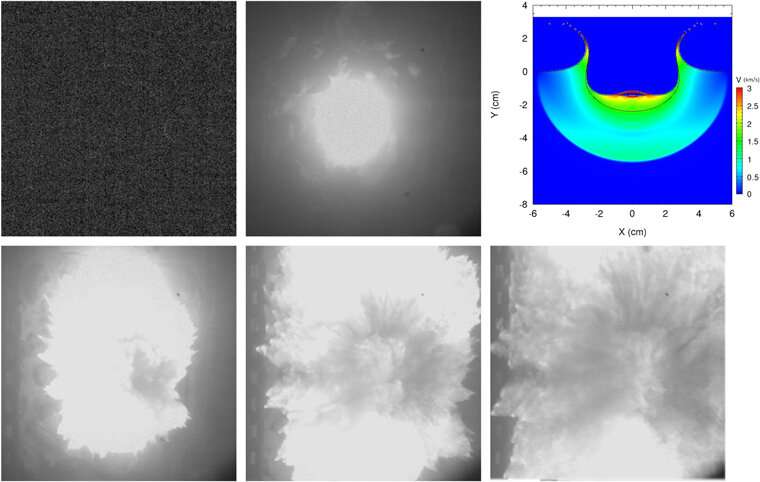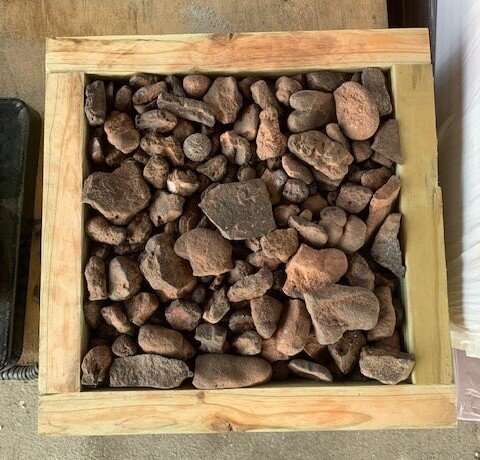Experiment helps predict effects of DART impact

On September 26, NASA's Double Asteroid Redirection Test (DART) spacecraft crashed into Dimorphos, a moonlet of the near-Earth asteroid Didymos, at 14,000 miles per hour. Prior to the impact, Southwest Research Institute engineers and scientists performed an experiment to study the cratering process that produces the mass of ejected materials and measures the subsequent momentum enhancement of the impact.
The experiment, which used a more realistic target than those previously explored, is described in a new paper published in The Planetary Science Journal.
NASA not only tracks near-Earth asteroids (NEAs) that could pose a possible impact threat to our home planet but is also exploring technology to deflect the path of a small NEA. Only a small orbital change would be needed to change an object's trajectory so that it passes safely by Earth, as long as the change is applied sufficiently far in advance of the time of impact.
Changing the momentum of an asteroid through a direct collision offers a one-two punch: the direct momentum transfer of the impacting projectile, pushing it forward, and the asteroid's recoil from the debris erupting from the impact crater, also known as crater ejecta. The ejecta transfers momentum, propelling the target away in an "action-reaction" fashion, much like a rocket launches when high-speed gas erupts from the rear of the vehicle.
"One big question we faced was what the asteroid would actually look like and what its composition would be. Whether we can learn something from small-scale laboratory experiments is an issue of major interest to us," said Dr. James D. Walker, director of SwRI's Engineering Dynamics department and the study's lead author.
Walker is a member of the DART Investigation Team alongside his co-authors, Dr. Sidney Chocron, Donald J. Grosch and Dr. Simone Marchi.
The DART mission spacecraft launched from Earth in November 2021. On September 26, it was deliberately crashed into the moonlet Dimorphos to assess whether a spacecraft could deflect an asteroid on a collision course with Earth. Dimorphos orbits the asteroid Didymos, a near-Earth object that has been classified as a potentially hazardous asteroid. DART is designed to nudge the orbit of the moonlet around Didymos.
SwRI's large two-stage light gas gun, which is capable of launching projectiles at speeds up to seven kilometers per second, was used to launch a projectile at an object representing the moonlet. Because Dimorphos was thought to be a "rubble pile" asteroid made up of pieces of rock bound together by gravity, the moonlet was represented by a collection of rocks and stones, in this case held together by cement.

"We fired an aluminum sphere, which represented the DART space probe, using the two-stage light gas gun at the target at 5.44 kilometers per second, which is approaching the expected 6.1 kilometers per second of the DART impact," Walker said.
"Our experiment measured a momentum transfer to the target of 3.4 times the incoming momentum of the aluminum sphere projectile. The number 3.4 is referred to by scientists as the Greek letter beta of the impact. Hence the crater ejecta provided an additional 240% of momentum to deflect the body, beyond that provided by the projectile itself."
The experiment aimed to study the cratering process and measure the momentum enhancement that would result from the collision. Crucially, the rubble pile was not held in place but was hung vertically as a pendulum to measure the momentum enhancement, or recoil, created by the impact ejecta.
"It's important to understand the amount of recoil," co-author Dr. Simone Marchi said. "It all boils down to the amount of momentum that has been transferred to the target from the impact, and there was a significant amount of recoil and ejecta material."
By measuring the momentum, the SwRI team could then extract important information that could assess the difficulty of deflecting asteroids in space. In this latest experiment, the momentum enhancement was higher than what was witnessed in the team's prior experiments. A higher recoil suggests it would be easier to deflect the asteroid.
In the weeks following the impact, NASA announced that DART had been successful in nudging the moonlet. Walker is now looking forward to seeing what else can be learned from the mission, including the momentum transfer of the event in space.
"It will take a while to compute the data, in part because it involves estimating the mass of the moonlet, which is unknown," he said. "Once there's an agreement on the mass, then the measurement of the change in the moonlet's orbit will tell us the momentum transfer. We have a speculative body that we've impacted and what we'd really like to know is how size affected things. It will be a challenge to determine that."
The paper appears in The Planetary Science Journal.
More information: Simone Marchi et al, Momentum enhancement from a 3-cm-diameter aluminum sphere striking a small boulder assembly at 5.4 km/s, The Planetary Science Journal (2022). DOI: 10.3847/PSJ/ac854f
Journal information: The Planetary Science Journal
Provided by Southwest Research Institute




















